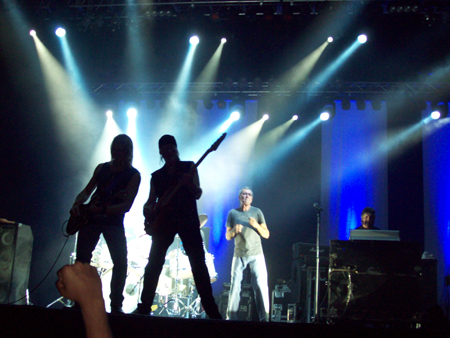 I bought my copy of the new Deep Purple DVD History, Hits and Highlights 3 weeks ago. This is my review. The title – odd as it sounds – has some justification after seeing it a couple of times.
I bought my copy of the new Deep Purple DVD History, Hits and Highlights 3 weeks ago. This is my review. The title – odd as it sounds – has some justification after seeing it a couple of times.
There is a great number of highlights indeed which easily justify this purchase – incredible live performances from various dates. Some of them songs that weren’t played live very often and up to now unobtainable even on audio releases, such as “Demon’s Eye” – which gets a creative treatment here and somehow transforms into the vocal-guitar battle of “Strange Kind of Woman” – or the “Musikladen” appearance of “No, No, No”, which may not catch the band in their tightest moment, but nicely displays the daring approach of those days: always urging to depart from the original, improvising and searching for the magic moment.
There is truckloads of those magic moments in the previously unreleased footage of the more familiar MK I tunes, “Wring That Neck” and “Mandrake Root” from late 1969 and 1970. It’s hard to find words for the energy level contained here: a band in a creative frenzy, an almost desperate determination to create sounds that nobody heard before, to turn the concert into an extraordinary experience for audience and band. Unbelievable!!!
All right , there are the hits as well. Inevitable as they are with regard to the bands history, the form in which they are presented on the DVD isn’t quite up to the mark. More often than not they combine the familiar album tracks with some more or less imaginative video. At best, this presents mildly amusing contemporary ideas of artsiness (Help, Speed King) or is at least funny when Ritchie takes the playback in Fireball all too seriously and plays his guitar on its backside. But sometimes it’s only stupid, like the pathetic video to “Strange Kind of Woman” or the blurred snippets from various live performances that flicker over the screen during “Never Before”. Thank god, there’s a “skip” button on my remote control.
The History aspect is a mixed bag. Of course every clip is a strong document of the history of the band as well as of the time period in general. [see report on Made In Japan footage included. Ed] The transformation of band, music, appearances, styles, venues and audiences in those 8 years is astonishing: The MK I days with a slightly uneasy, almost self-conscious band contrasting nicely with their own stylised fashion and the somewhat forced party atmosphere in Hefner’s Playboy Mansion.
The MK II period in an often raw, almost puristic setting: One of the venues literally looks like a lecture hall of a university (guessing from the booklet of “Scandinavian Nights” it actually IS Leeds University), in which apart from setting the stage no effort whatsoever has been made to accommodate for the special atmosphere of a rock concert: No backdrops, no lights, nothing! Audiences are mostly seated (in bright light!!!), with a weird mix of long-faced poofs “seriously listening to the music” and a few exalted hippies freaking out and emulating the mayhem on stage.
Musicwise it’s surely annoying to have the audience comments dubbed over “Demon’s Eye”, just because it’s such a rarely performed song. But the comments as such are revealing – nerdy guys complaining about Purple not improvising and merely going through the motions, when you can actually hear them jamming their heads off! Hilarious!
Come Mk III and it’s all proper rock’n’roll shows, with a huge lightshow, clouds of dry ice and the proverbial sweaty crowd of hardrock fans – and before long the stereotypical rockstar poses kick in.
Apart from the strength of the original material there’s not much in this release that does justice to the term “history”. The initial twenty minutes are nice, but have a somewhat “rushed” feel to it – the snippets used are all too short to be really informative, and some of them must have been longer! As it is presented here, the history doesn’t contain anything the informed fan wouldn’t know anyway but I doubt that any uninitiated viewer can make something out of those very condensed and sometimes rather allusive than outspoken minutes. But the decision as such to tag the history on at the beginning and leave the rest of the material to speak for itself can’t be criticised.
More critical is the way this material is presented. The division on two discs is irritating to say the least – if disc 2 isn’t what is usually called a “bonus CD” it’s a somewhat poor excuse to include the same material twice.
From a historical point of view, it’s sad, that the MK II songs aren’t presented in chronological order. After “Child in Time” you get “Lazy” from Denmark which was recorded in 1972 shortly before “Machine Head” was released. Then it’s back to the Fireball-period with “Strange Kind of Woman” and then even further back to Winter 1970/71 to the writing sessions of Fireball. It’s also hard to understand, why “Demon’s Eye” and “Into the Fire”, which originate from the same concert, are interrupted by “No No No”. Very unhistorical if you ask me!
The same – somehow careless – approach shows in the missing information about the origin of the footage on Disc 1. How can something that bears the word “history” in its title not name the sources? Inexplicable and inexcusable is of course the complete omission of the “Stormbringer” album, all the more so, as you see some 10 seconds from a live performance of the title track in the “history”-part. Why don’t we get to see more?
That such a number of questions remains unanswered is also due to the quality of the booklet – which is rich in visual material but poor in text. Geoff Barton doesn’t contribute much more than the predictable blabla. As such, the booklet falls way short of the standard that Simon Robinson has set with the Sonic Zoom releases in which he went out of his way to explain the special circumstances of the respective release, where they found the footage, how much it contained, what choices had to be made, which drawbacks had to be accepted etc. etc. With the booklet of the HHH release, the fan is left to his own devices, which may also raise unfair criticism.
A bit annoying is also the selection or rather restriction of the material. As much as I value the effort to bring in material from a wide range of sources, sometimes it seems that several tracks have been left out on purpose in order to maintain the interest level for other releases. The “Doing their Thing”-video, from which “Child in Time” has been taken, isn’t very easy to get and with only 3 songs not the best value for money either, but it contains a blistering rendition of “Speed King” which I would have loved to see on this DVD.
The same goes for “Fireball”, which is on the “Live in Denmark Video”. This on the other hand, wouldn’t have killed the market for the full video. And for a good extra, they might have as well thrown in the remaining three titles of the obscure “Rises over Japan” video – I doubt many people will buy this one.
So is it worth the money? As always with those releases – yes. Does it have its drawbacks? Again – yes. Unfortunately they always manage to get their fair share of incomprehensible blurs on their releases.
Compared to the Led Zeppelin DVD, which is immaculate in every respect, this is a shame. But as someone put it – that’s what happens if you hire pencilheads.
Crazy Horst
![[hand]](/hs-pics/portraits/hands/paice3.jpg)
![[face]](/hs-pics/portraits/faces/glover3.jpg)








 Unauthorized copying, while sometimes necessary, is never as good as the real thing
Unauthorized copying, while sometimes necessary, is never as good as the real thing